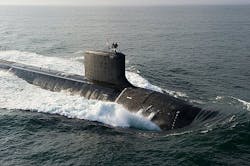Navy orders TB-29X towed-array sonar sensor systems to detect nuclear- and diesel-electric submarines
WASHINGTON – Undersea warfare experts at L-3 Chesapeake Sciences Corp. in Millersville, Md., are building more of the U.S. Navy's next-generation towed-array sonar to enable Navy submarines to detect, track, and classify quiet, modern submarine threats in the open ocean and in shallow coastal waters.
Officials of the Naval Sea Systems Command in Washington announced a $43.1 million order to L-3 Chesapeake on Friday to build TB-29X towed arrays for Navy submarines.
The TB-29X is the future-generation reliability improvement to the TB-29A towed-array sonar. It is a 416 channel thin line towed array with an equivalent acoustic performance capability to TB-29A. The TB-29X is a thin line towed array passive sonar receiver that has the same form factor as the TB-29 array, yet offers increased capability, greater reliability, and reduced obsolescence.
Towed array sonar uses hydrophones towed on a cable trailing behind a submarine or a surface ship; it can be miles long. It's designed to keep the array's sensors away from the tow vessel noise to improve its signal-to-noise ratio and its ability to detect and track faint contacts like quiet nuclear- and diesel-powered submarines and seismic signals.
Effective use of towed array sonar systems limit a vessel's speed, and crews must take care to protect the cable from damage. Current towed-array systems also are complex designs and need to be upgraded to maintain reliability while deployed, while stowed, and while reeling the array in and out of submarines and other marine vessels.
Related: L-3 to build submarine towed array sonar systems with enhanced capability and reliability
Compared with existing towed arrays, the L-3 Chesapeake TB-29X offers significant reduction in sensor power, internal component diameter, bend radius, and production costs.
The TB-29X submarine thin-line array is designed to reduce complexity, lower power, and improve robustness to withstand in-situ operations and stresses of handling systems.
Its performance telemetry, acoustic sensors, and electronics are designed to provide a ubiquitous solution for submarine, surveillance, and unmanned towed arrays. This multi-mission commonality for these high-volume and unique components provides cost savings from procurement to life cycle support.
On this contract L3 Chesapeake Sciences will do the work in Liverpool, N.Y.; Millersville, Md.; and Ashaway, R.I., and should be finished by January 2022. For more information contact L3 Chesapeake Sciences online at www2.l3t.com/csc, or Naval Sea Systems Command at www.navsea.navy.mil.
Ready to make a purchase? Search the Military & Aerospace Electronics Buyer's Guide for companies, new products, press releases, and videos

